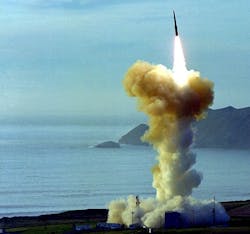Boeing to upgrade missile guidance systems on Minuteman III land-based nuclear rockets
HILL AIR FORCE BASE, Utah, 1 June 2016.Missile guidance experts at the Boeing Co. will continue upgrading the guidance systems on U.S. Minuteman III intercontinental ballistic missiles (ICBMs) under terms of an $8.1 million U.S. Air Force contract modification announced Monday.
Officials of the Air Force Nuclear Weapon Center's Intercontinental Ballistic Missile Systems Directorate at Hill Air Force Base, Utah, are asking the Boeing Directed Energy & Strategic Systems segment in Layton, Utah, to upgrade the communications equipment interface unit (CEIU) in the Minuteman III ICBM guidance system.
The order asks Boeing to provide engineering and manufacturing development (EMD) for the nuclear missile's CEIU. EMD means full-scale development.
Boeing engineers will provide updates to the Minuteman III's legacy CEIU to a more robust software language and change the communication protocol from telephony to internet protocol to address security concerns.
Related: Air Force asks Boeing to upgrade test gear for nation's Minuteman III nuclear missiles
This project is called Performance Assessment Data System Communications Equipment Interface Unit (PADS CEIU), which is an interface unit using an analog signal over the telephone line using a standard commercial off-the- shelf (COTS) modem.
This system is essential, Air Force officials say, because it is the only way to identify high hour pendulous integrating gyroscopic accelerometers (PIGA) and provide data that eliminates unnecessary missile guidance set (MGS) removals.
Last February Boeing won a $15.6 million contract modification to continue upgrading and maintaining guidance systems on the U.S. Minuteman III nuclear missile fleet.
The orders from Monday and last February are modifications of a $51.2 million contract awarded to Boeing in January 2015 to provide sustaining engineering and program management support for the ICBM guidance subsystem. The primary focus of the original contract was to ensure any modifications or changes to the guidance system would maintain and improve system-level performance of the Minuteman III ICBM.
Related: Incoming! Precision guidance keeps munitions on target
The U.S. Minuteman III fleet constitutes one-third of the nation's nuclear weapons deterrent. Other U.S nuclear warheads are on submarine-launched ballistic missiles and on manned jet bombers.
Each Minuteman III missile is 60 feet tall, 5.5 feet in diameter, and powered by three solid rocket motors that can launch the 80,000-pound missile to altitudes of 700 miles to deliver nuclear warheads as far away as 6,500 miles. Each missile contains as many as three independently targeted warheads in separate reentry vehicles.
The U.S. maintains Minuteman III missiles at 450 missile sites in Colorado, Montana, Nebraska, North Dakota, and Wyoming. The missiles themselves are in underground silos and are ready for launch on very short notice.
The Minuteman III originally was equipped with a Rockwell Autonetics D37D flight computer, but as of 2008 had been upgraded as part of the Minuteman-III Guidance Replacement Program (GRP). Boeing acquired Rockwell Autonetics in 1996, and the Boeing Integrated Defense Systems segment in Heath, Ohio, was in charge of the GRP initiative.
Related: Nuclear ballistic missile command and control
Boeing experts installed the NS-50 missile guidance computer (MGC) based on a 16-bit high-speed microprocessor, which helps the missile correct positional errors and generate steering signals.
Minuteman III computer programs are stored on a magnetic tape cartridge. The computer also controls the alignment of the inertial measurement unit, and performs test and monitoring of the missile's guidance and control system. Other parts of the Minuteman-III's latest guidance system include the Gyro Stabilized Platform (GSP), Digital Control Unit (DCU), Missile Guidance Set Control (MGSC), and the Amplifier Assembly.
Boeing provides sustaining engineering, modifications, and upgrades for the U.S. Minuteman III ICBM fleet, which is manned 24/7 by U.S. Air Force officers. Boeing is responsible for guidance, flight controls, secure codes and ground subsystems, as well as designing, testing, modernizing, and repairing Minuteman III ICBM systems and components.
On the Minuteman III ICBM support contract announced Monday, Boeing will do the work in Layton, Utah, and should be finished by June 2018. For more information contact Boeing Defense, Space & Security online at www.boeing.com/defense, or the Air Force Nuclear Weapon Center's Intercontinental Ballistic Missile Systems Directorate at www.hill.af.mil

